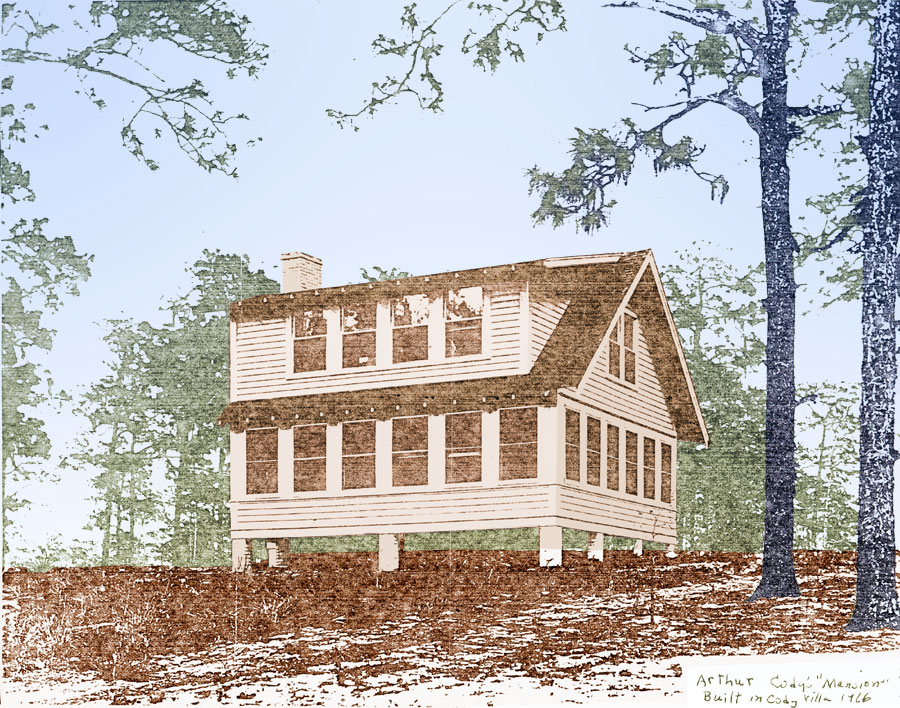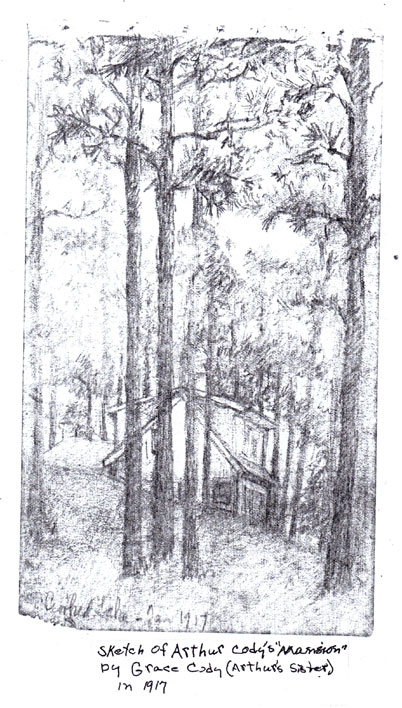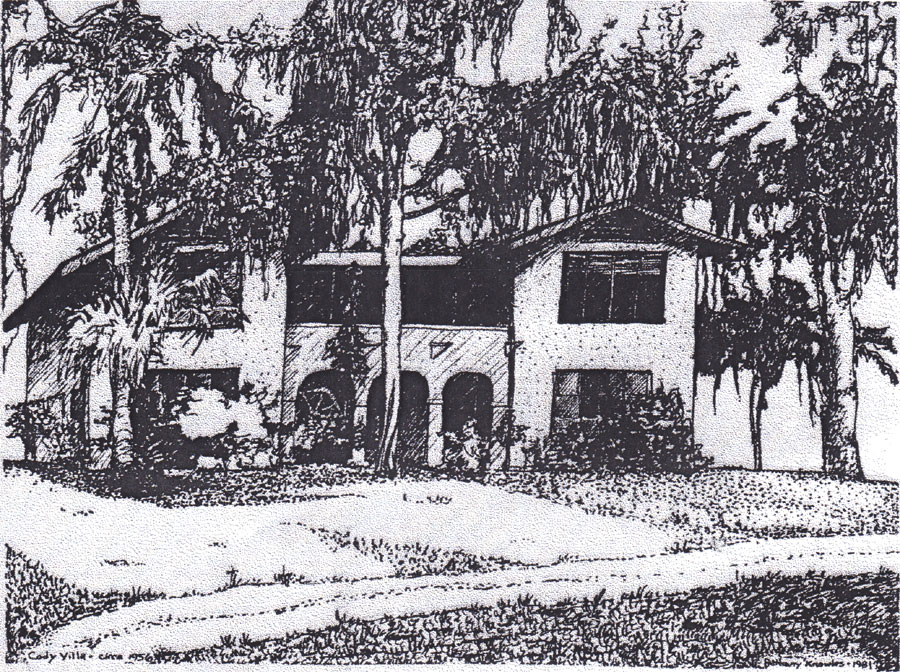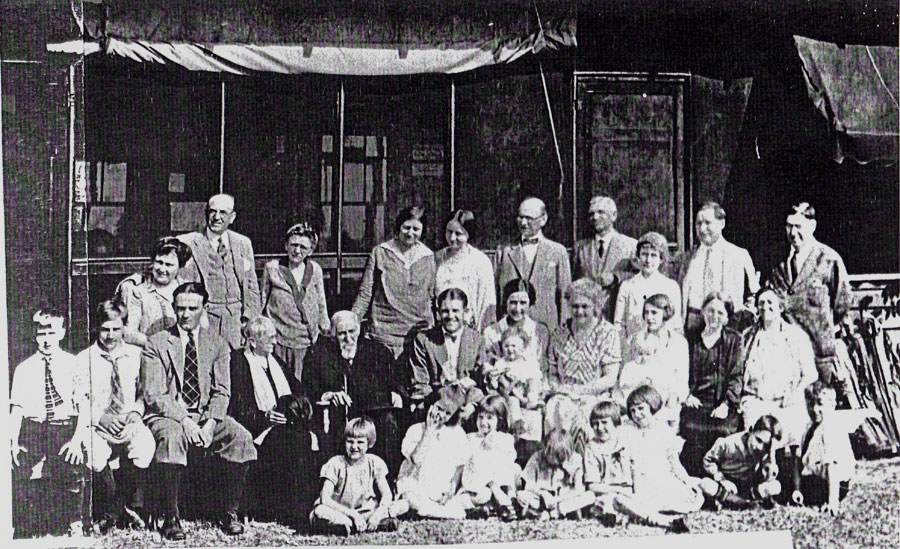Middle row, Arthur, Gertrude, Ethel, Frank & Mary Amelia; Back row, Lydia, Grace & Harry

|
The Codys of Cody Villa, 1896 - 1976
CODY VILLA---1894-1976ELIZABETH CODY MOORE B:1910-D:1996 In February 1896, my Grandfather, Lindus Cody, and his nephew, Luther Cody, accompanied Mr. E. Alonzo Cordery of Ft. Mead to the shores of Crooked Lake and the pine hill overlooking the harbor. (2) Mr. Cordery was a promoter who saw the need of a railroad into the region. He and the Huddlestons had purchased the land in 1883 for $1.00 an acre from the Internal Improvement Fund. Although they had the land laid out in lots, nothing more had been done. Grandfather saw the possibilities in the land as a town site and made several attempts to get the needed backing to put in a railroad. Among his contacts were a group of men from England and a Dutchman, Mr. Van Leyden, who he met in Cuba. Presumably, Mr. Cordery was also looking for a company to purchase the railroad bonds. By 1900 nothing had come of the railroad idea but Grandfather decided to go ahead on his own to buy the property. In 1901 the deeds were drawn up for approximately 1,000 acres on Crooked Lake. Early in 1902 he and Grandmother came to Florida to see the property. Grandmother wrote, "It is beautiful out there; no doubt about it." They "boarded" with the Carson family in Frostproof but Grandmother said, "Never again". They have only fish and game at the table and the fleas make life miserable, so the following winter Grandfather bought a grove in Frostproof on Lake Clinch and built a little 3-room cottage so Grandmother could keep house. Grandfather made frequent trips to Crooked Lake that winter, probably going on foot to plan the grove and supervise clearing the land. Occasionally he borrowed a horse and wagon and took Grandmother with him. It was a five mile trip on a sand trail through the woods with not a person or house to be seen the whole way. By the next year he had built a cabin for a man to live in to take care of planting the grove and a vegetable patch. Grandmother wrote of going to Crooked Lake to get fresh vegetables and go fishing. She always seemed to bring home a string of fish. They cooked a picnic lunch over a campfire on these trips. In 1905 Grandfather had a little cottage built for their use. The description we have of this cottage is of homemade bedsteads and mattresses filled with pine straw. Grandfather made a table, which Grandmother complained she couldn’t write on as one leg |
|
was too short. Grandmother said it was too lonesome there at night and too far from any neighbors so they stayed most of the time in the Frostproof house. A family named Carter with several children lived there for a time. In 1908 Aunt Lydia spent several months supervising the grove work, living alone in both Frostproof and Crooked Lake. She spent the summer of 1912 alone at Crooked Lake also and by that time Ted Byron was living not far away. They shared the use of a horse when the horse was not hauling fertilizer. In 1909 Grandfather gave my Father, Arthur, ten acres for a wedding present. My Uncles Harry and Frank each had land also and they were all planting their land in citrus.
Every trip to Florida, usually January to April in those days,
In 1912 Aunt Gertrude married Will Wheaton and they spent their
By 1912 the long talked about railroad was at last realized and a
There were still no paved roads, but the sand trails now had pine |
|
During these years, before the railroad the family brought barrels of food with them from Cleveland, listing such things as butter and beef that one wonders how they were shipped and kept since there was never any refrigeration.
In 1914 or 1915 Andrew Marsh built another small house on the top
In January 1916 my Father brought my little brother, Philip, my
The following winter Frank, Ida and Willis lived in that house and any whom needed it. During 1918 to 1920 it was used as a common dining room. A cook lived there and all the families had their meals together. I’m not sure how many winters that arrangement was |


In 1917, Grace Isabelle 148/29 did this sketch of her brother Arthur's house at Crooked Lake. This is her bio from sister Lydia's 1954 book, "The Cody Family Massachusetts 1698" Note that she is identified by "838" in Lydia's sequential numbering system.
838 Grace Isabelle, b. Jan. 6, 1882 at Cleveland, Ohio. She attended Cleveland Public schools, is a graduate of Cleveland Art Institute 1906; New York School of Art, Normal Department 1907 of Teachers College, Columbia University; Household Management course 1918.
She was Director of Varick House of Spring Street Settlement, New York City, 1918-1920;
Director of Girls Friendly Club, Cleveland, Ohio, 1912-1918, 1920-1922. A member of Cleveland Girl Scout
Council 1928-1946;
Vice Chairman of the board of the Mary Ingersoll Club 1928-1946, Chairman 1946-1954.
Presbyterian, member of the Church of the Covenant, Cleveland. Republican.
Her sketch is entitled "Crooked Lake 1917", the use of the Cody Villa name came in the 1920s.
|
|
followed. About 1918 the little cottage was moved back and Frank built his home facing the lake. A year or so later my Father’s house was moved to a lot to the north and Harry Cody built his home on that site. Also, during those years, Gertrude and Will built their cottage. By 1920 there were six homes on top of the hill overlooking the lake.
As the amount of acreage planted to citrus increased, Frank took
The winter of 1919-1920 Ethel Higginbottom and her family were
In 1921 we moved to Florida to stay the year round. Frank and Ida
By 1923, our house was far too small for six children so a wing was name changed to Babson Park." “Everybody is delighted but the boys, Arthur and Frank will get no commission for all their work." "They should, I say." These were the years of the Florida boom and my Father and Uncle Frank had helped Mr. Babson acquire the land around the |

Arthur added a wing in 1923 and another in 1925. This sketch is by Bethany Knowles, done in 1956.
|
|
Crooked Lake town-site, which was to become a model town for Mr. Babson, the wealthy Massachusetts financier.
Many of the letters in this period mention parties at The Lodge, teas,
While the Boom was at its highest, Arthur, Frank and Harry
In the spring of 1926, the family had a picnic at the Golf Club across
The decade of the ‘30’s were years of struggle as fruit prices dropped
In the 1940’s the Higginbottoms returned from India and built their left for college and careers, and the older members of the family died. |

Four generations of Lindus and Amelia's Cody family at the Babson Park Golf & Yacht Club, spring 1926.
Front row (seated on the ground): Dorothy Cody, Trudie, Dolly, Sarah, Martha, Jane H, David & Henry H? Middle row (seated): Philipe, "Bill" Wheaton, Willis Judson, Grandmother Amelia, Grandfather Lindus, Louis F. (Harry), Jane S. (Louis' wife, holding "Baby Jane" Cody), Elma C. Cody, Betty Cody holding Peggy Cody (Arthur), Mary and Ethel Back row: Marie D. Cody (Arthur), Arthur P. Cody, Lydia, Grace, Gertrude (Cody) Wheaton, Harry Cody, Frank Cody, Ida B. Cody (Frank), William Wheaton and Sam Higginbottom |
|
Much of their property was sold so that now many other families live in Cody Villa.
My sister Sara bought the Homestead house; my Mother made our
Many of the third, fourth and fifth generations enjoy visiting here
The Cody’s helped establish the Community Church and served as as Cody Villa. |
|
|